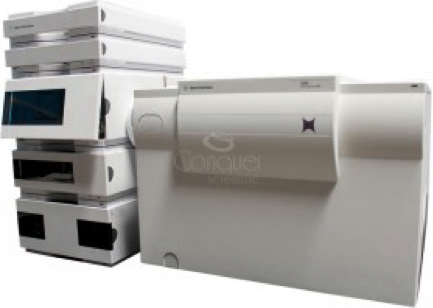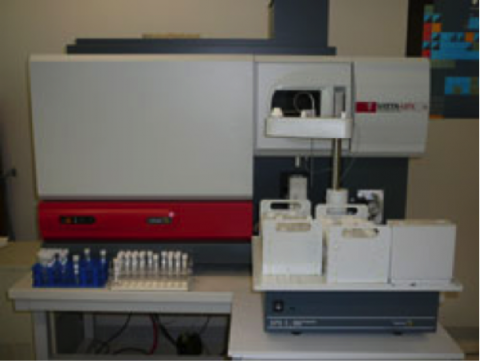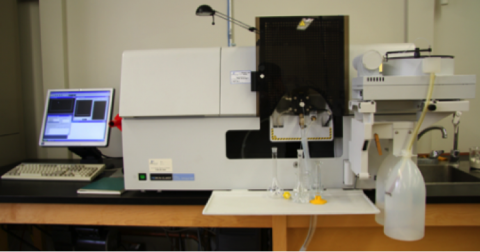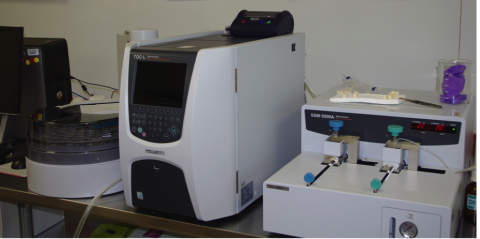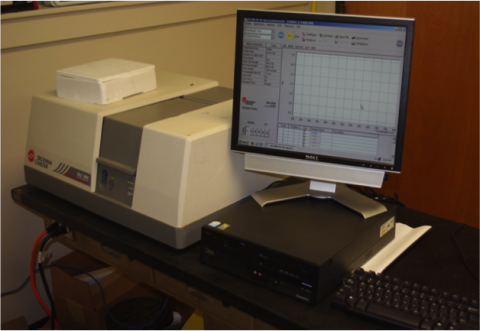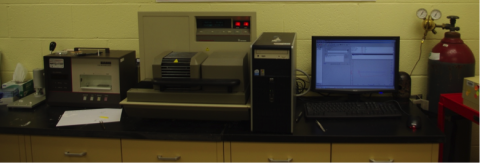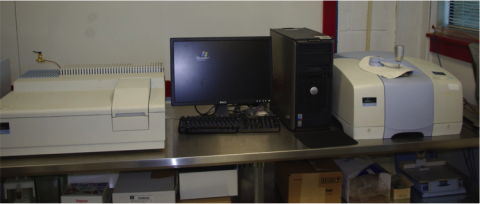Analytics & Process Chemistry Laboratories
The Energy Institute of Louisiana’s analytical instrumentation is located in Madison Hall on the campus of the University of Louisiana. Our laboratories house both workhorse and state of the art research instrumentation.
The Institute has the ability to respond to simple molecular weight determination, characterization of complex mixtures, residue analysis as well as challenging method development. The method development aspect allows the facility to support cutting edge researchers within the academic institution. Staff has full operational remote control of systems via secure Internet for maximum uptime and throughput.
Overall Facility Resources

GC & LC Laboratory, Madison Hall Room 206
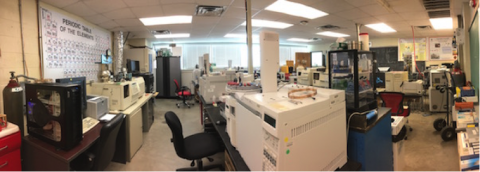
Mass Spectrometry Laboratory, Madison Hall Room 228

Analytics Training Center, Madison Hall Room 220B
Major Instrumentation
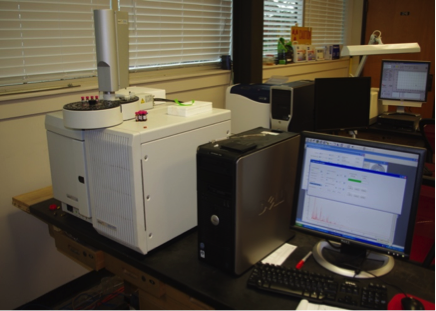 Varian Quadruple Ion Trap Mass Spectrometer (MS)
Varian Quadruple Ion Trap Mass Spectrometer (MS)
The facility hosts six systems that have standard electron impact and wave board technology which allows the implementation of chemical ionization, selected ion storage, and tandem mass spectrometry. Systems are used for residue analysis in a wide variety of complex matrices such as soil, water, petroleum, and air. Low part per billion and trillion detection levels can be employed with the use of the large volume injection (LVI) technique. The use of solid-phase microextraction (SPME) can also be exercised and automated. Use of SPME allows the analysis of liquid, solid, gas, and ambient air without extraction. Two MS systems have built-in high temperature catalytic cracking units for the study of catalytic materials and kinetic studies. This in house technology development has led to catalysis analyzers coupled to both conventional GC detectors and mass spectrometers.
Agilent Quadruple Mass Spectrometer (MS)
The facility hosts three systems that have standard electron impact technology. These systems are the workhorse instruments for the institute. They are fully automated with a 100-sample capacity and can operate in both high sensitivity mode or for complex samples such as petroleum or environmental samples. Each system has the ability to positively identify compounds in mixture and allows for rapid method development along with high sample throughput.

Bruker Esquire
The facility has two state-of-the-art mass spectrometers with the ability to perform both positive and negative ion detection. It can operate in both the single and multiple MS modes including MSn. These systems can support higher resolution for low-level determinations not possible on high performance liquid chromatography (HPLC) systems. These are equipped with electrospray (ES), atmospheric pressure chemical ionization (APCI), atmospheric pressure photo ionization (APPI), and HPLC inlets. One system has electron transfer dissociation (ETD) capability, which in the field of lipidomics has been shown to be a mass spectrometric tool for the identification and quantification of molecular lipids in complex matrices. Lipids present some unique advantages and challenges for mass spectrometric analysis. The application of electrospray ionization to crude lipid extracts without prior fractionation, the so-called shotgun approach, is one such example, as it has perhaps been more successfully applied in lipidomics than in any other discipline.
Liquid Chromatography (LC)
The facility contains five systems for either stand-alone LC’s or connected to MS systems. Two LC’s are dedicated for ion chromatography. The remaining three are standard systems with ultraviolet (UV), refractive index (RI), or evaporative light scattering (ELSD) capability. All systems are fully automated with a 100-sample capacity.
Gas Chromatography (GC)
The facility contains five systems for either stand-alone LC’s or connected to MS systems. Two LC’s are dedicated for ion chromatography. The remaining three are standard systems with ultraviolet (UV), refractive index (RI), or evaporative light scattering (ELSD) capability. All systems are fully automated with a 100-sample capacity.
Inductively Coupled Plasma-Atomic Emission Spectrometer (ICP-AES)
This is a well-established and cost-effective technique for multi-element analysis. Samples in solution are introduced as an aerosol into a plasma at temperatures in the order of 6,000-10,000K. This process effectively converts the elements present to gaseous atoms and then ions. The ions are elevated to excited states and emit light radiation at characteristic wavelengths as they “relax” to ground state. A spectrometer is used to separate the light emitted, and the light is detected using a photo multiplier tube (PMT). The facility has a Varian Liberty AX Sequential ICP-AES. This unit has a horizontal plasma torch with a detection range of 175-940nm. The unit also has an autosampler SPS5 to fully automate the system.
Atomic Absorption Spectrometers (AA)
The facility has a Perkin Elmer 800 series AA spectrometer with a space-saving stacked design featuring both flame and furnace capabilities on a single instrument. It includes longitudinal Zeeman background correction combined with its high light throughput optical system and solid-state detector. The system is equipped with an autosampler to maximize sample throughput.
Total Organic Carbon Analyzer (TOC)
The TOC analyzer from Shimadzu adopts the 680°C combustion catalytic oxidation method while providing an ultra-wide range of 4 μg/L to 30,000 mg/L. This is the highest level of detection sensitivity available with the combustion catalytic oxidation method. This technology efficiently oxidizes easily decomposed, low-molecular-weight organic compounds but also hard-to-decompose insoluble and macromolecular organic compounds. The system has capability of solid sample and automated water analysis.
Infrared Spectroscopy (FT-IR)
FT-IR applications are used for troubleshooting manufacturing problems, identifying product contaminants, analyzing fuels and gaining deeper insights into the properties of novel and advanced materials. The PerkinElmer FT-IR system is a flexible, highly configurable system yielding fast and accurate data analysis.
Ultra Violet Spectroscopy (UV)
The Beckman Colluder DU800 spectrophotometer has many unique features, including a source scheduler that can turn both the UV and visible lamp on and off independently at specified times each day. A performance validation scheduler warms up the system automatically and then performs specified test(s) at a given date and time. Another capability of this UV system is cell matching, which corrects minor differences in multiple cells. Designed with a micro-focused beam, the DU-800 delivers the full energy of the beam to the microsample, unlike standard beams which can lose as much as 80% of their energy when applied to a microvolume sample. Sample automation is accomplished through the use of a multi position sample holder.
Thermogravimetric Analyzer (TGA)
TGA analyzer continuously measures mass while the temperature of a sample is changed over time. Mass, temperature, and time are considered base measurements while many additional measures may be derived from these three base determinations.
Instrumentation Maintenance and Repair
All analytical instrumentation is maintained and repaired by EIL personnel. Staff having a combination of over 50 years of experience in instrument design and operation keeps downtime of analysis to a minimum.

